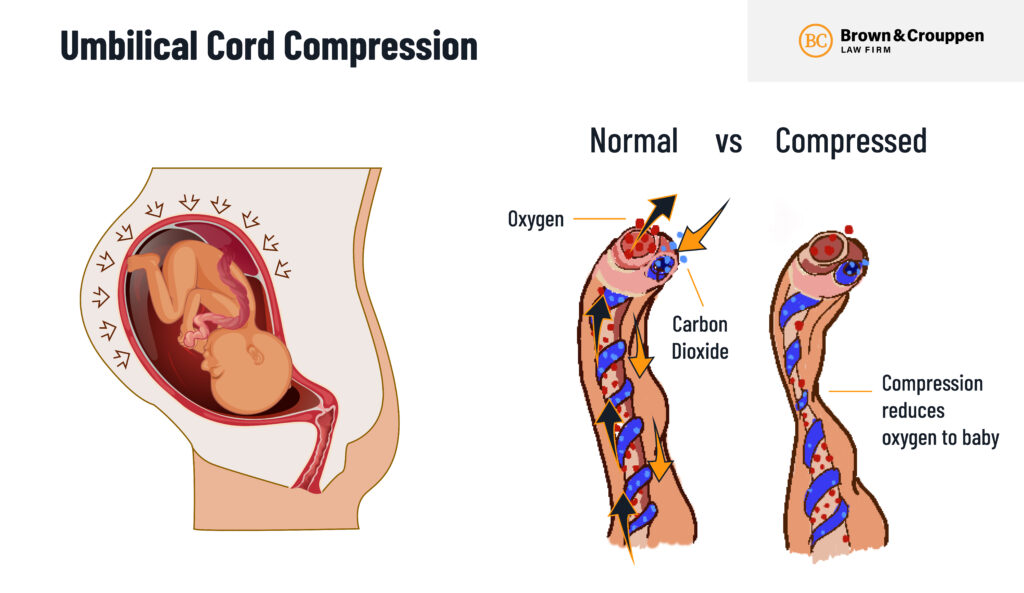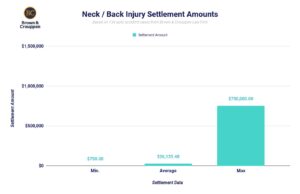Umbilical Cord Compression Symptoms & Signs
Some pregnant mothers begin to notice symptoms of umbilical cord compression, such as a decrease or increase in fetal activity. Movement in the womb often relieves the compression, but not always. Compression is most noticeable when caused by an umbilical cord prolapse, which occurs when the cord exits the cervix before the baby moves through the birth canal.
In most cases, compression happens without the mother’s awareness. However, they should seek medical attention immediately if they notice signs. Prenatal care teams should also monitor for signs, such as:
- Changes to fetal heart rate
- Too much or too little amniotic fluid
- Restricted fetal growth
By recognizing and treating umbilical cord compression as early as possible, medical teams can reduce the risk of birth injuries to the mother and baby.

What Causes Umbilical Cord Compression?
Umbilical cord compression may occur during pregnancy or delivery. Any cause of umbilical cord compression can have serious consequences. Healthcare teams need to be aware of the signs to monitor the mother.
Among the most common causes is a nuchal cord, which refers to the wrapping of the umbilical cord around the baby’s neck. Nuchal cords happen in upwards of 29 percent of pregnancies. This normally resolves without long-term effects, but a tightly wrapped cord can also block the baby’s blood supply. In turn, this blockage interrupts the flow of oxygen and can lead to long-term damage.
Prolapse is a somewhat rarer cause of cord compression. It typically occurs during labor close to delivery. There is a significantly better outlook if the mother receives immediate treatment.
Other possible umbilical cord compression causes include:
- Fetal hyperactivity – Babies tend to move more as delivery approaches. This movement can cause the cord to become entangled around the baby.
- Strong contractions – Uterine contractions during labor can cause the uterus or fetus to press against the cord.
- Cord knotting – In rare cases, a long umbilical cord can become entangled in knots and interrupt blood flow.
The Dangers of Umbilical Cord Compression
According to the American Pregnancy Association, a compressed umbilical cord is more likely when the compression lasts longer. Extended compression may cause serious cardiac or respiratory problems, such as:
- Variable deceleration – A drop in the baby’s heart rate, which compromises nutrient and oxygen delivery.
- Respiratory acidosis – Too much acid in the baby’s blood due to interrupted blood flow out of the fetus.
- Fetal hypoxia – A decrease in oxygen to the baby’s brain while in the womb, potentially resulting in serious complications or death.
Compression-induced hypoxia is rare but dangerous. Healthcare teams are responsible for noticing signs, especially in cases of elevated risk. Risk factors include:
- Premature delivery
- Multiple fetuses
- Advanced maternal age
- A long umbilical cord
- Mechanical complications, including shoulder dystocia
Shoulder dystocia is a delivery complication that occurs when the fetal shoulder is caught against the mother’s pelvic bone. Shoulder dystocia is a common cause of compressed umbilical cords. The tightness of the shoulder against the twisted torso can cause cord compression inside the birth canal, potentially restricting oxygen delivery.
Potential Complications
Umbilical cord compression can have severe effects in the delivery room and beyond. If the umbilical cord becomes wrapped around the neck, the baby is at risk of hypoxic-ischemic encephalopathy. This serious complication frequently results in death or long-term disability. Many infants with HIE go on to develop epilepsy, cognitive disabilities, or cerebral palsy.
Researchers have found that infants who suffer a nuchal cords are more likely to have spastic quadriparesis, the most severe form of cerebral palsy. Children with spastic quadriparesis generally require the highest level of long-term care.
Treatment Options
Immediately treating fetal cord compression is vital to restoring blood flow. Less severe compressions normally require less invasive treatments, such as delivering oxygen, IV drips, or changes in the mother’s body position.
However, if there are any signs of fetal distress, healthcare teams must act quickly. Potential interventions include:
- Medications to stop or slow labor
- Infusion of amniotic fluid
- Cesarean section
The medical team’s actions often make all the difference. If providers fail to recognize the signs or do properly treat the mother and fetus, there may be grounds for a medical malpractice lawsuit.
Legal Options for Umbilical Cord Injuries
lawsuit may allow you to recover damages from those responsible. Among other things, compensable damages may include:
- Medical expenses – Post-birth hospital care, diagnostics, treatment of complications.
- Mental health costs – Mental health support for affected mothers.
- Ongoing care expenses – Assistive devices, mobility aids, personal health care aides, and any other costs of a compression-related disability.
If the child dies due to complications associated with cord compression, wrongful death damages may also be available.
Why Seek Damages?
Compensation can help your family secure justice and cope with a serious birth injury, both financially and emotionally. However, if you are considering legal action, speaking with a lawyer as soon as possible is essential. In most cases, the Missouri medical malpractice statute of requires victims to file within two years of the date of injury. Missing the deadline normally results in your case being dismissed in court.
"When someone is injured, most people automatically think they're going to get their medical bills and out-of-pocket expenses back, but really, it's so much more than that. . . . Getting full justice means not only recovering those out-of-pocket expenses but also things that are intangible and really affect your day-to-day interactions with people you love."
– Andrea McNairy, Partner
How Our Skilled Attorneys Can Help
The trusted legal team at Brown & Crouppen is here to help you understand your options. We are dedicated to serving Missouri families inside and outside the courtroom. Because we care about giving back to the communities we serve, we volunteer with organizations like United Cerebral Palsy and the Juvenile Diabetes Research Foundation.
Our firm has what it takes to fight big insurance companies eager to deny you full and fair compensation. We have secured over $1 billion in settlements and verdicts for our clients and are ready to help you take the next steps. To schedule a free consultation with an experienced umbilical cord compression lawyer, call (800) 536-4357 or reach out online.
Related Reading
Explore these resources if you would like to learn more about birth injuries, medical malpractice, and related topics:
Sources
- Admin, A. (2023, July 25). Umbilical cord prolapse and compression. American Pregnancy Association. https://americanpregnancy.org/healthy-pregnancy/pregnancy-complications/umbilical-cord-prolapse/.
- Allen, K. A., & Brandon, D. H. (2011). Hypoxic ischemic encephalopathy: Pathophysiology and experimental treatments. Newborn and Infant Nursing Reviews, 11(3), 125–133. https://doi.org/10.1053/j.nainr.2011.07.004.
- Miles, K. (n.d.). Cord prolapse during pregnancy. BabyCenter. https://www.babycenter.com/pregnancy/health-and-safety/cord-prolapse_40008084.
- Mutchler, C. (2024, January 26). What is umbilical cord compression? Verywell Health. https://www.verywellhealth.com/umbilical-cord-compression-signs-and-complications-5187744.
- Peesay, M. (2017). Nuchal cord and its implications. Maternal Health, Neonatology and Perinatology, 3(1). https://doi.org/10.1186/s40748-017-0068-7.
- RSMo, Missouri Law, MO Law, Joint Committee on Legislative Research. (2005, August). Title XXXVI Statutory Actions and Torts. Missouri Revisor of Statutes. https://revisor.mo.gov/main/OneSection.aspx?section=537.090.
- What is umbilical cord prolapse? Cleveland Clinic. (n.d.). https://my.clevelandclinic.org/health/diseases/12345-umbilical-cord-prolapse.






